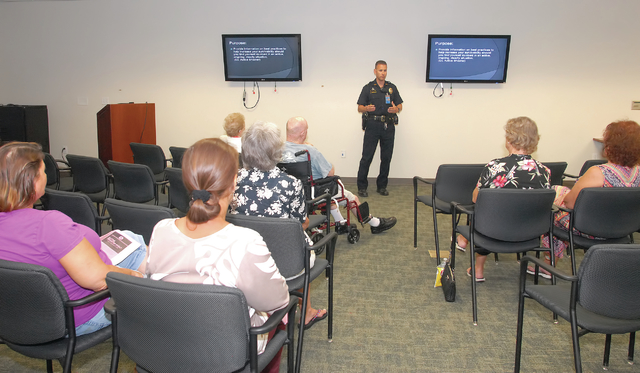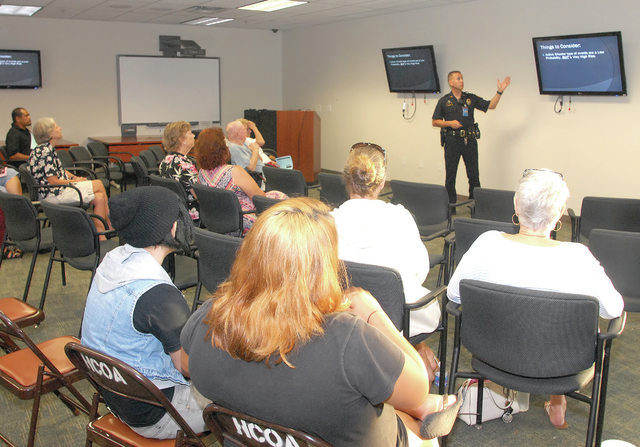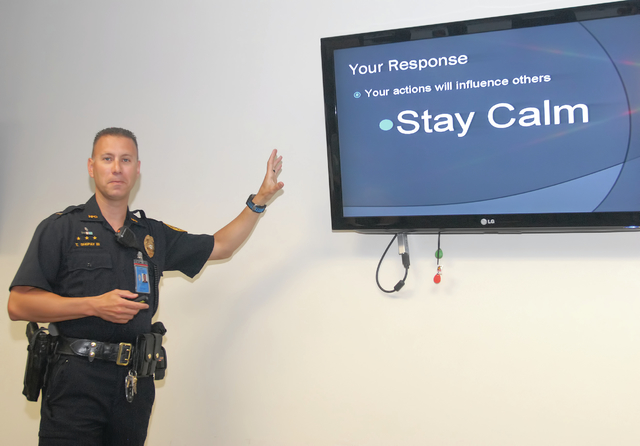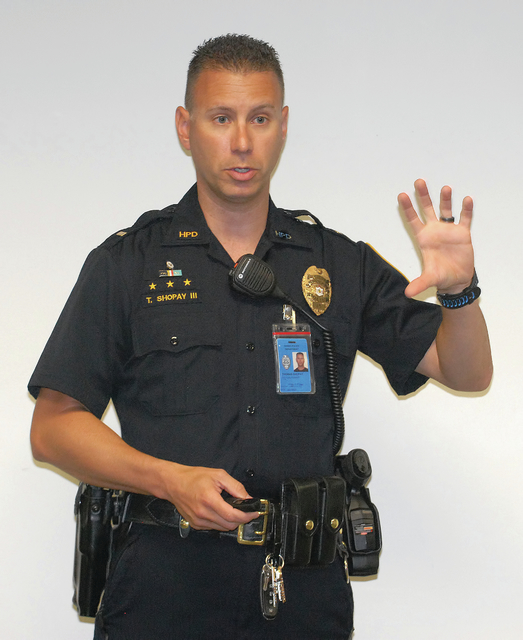KAILUA-KONA — For residents Jean Gray and Lynda Roark, it’s important to be prepared for perilous situations. ADVERTISING KAILUA-KONA — For residents Jean Gray and Lynda Roark, it’s important to be prepared for perilous situations. “Any place could be dangerous
KAILUA-KONA — For residents Jean Gray and Lynda Roark, it’s important to be prepared for perilous situations.
“Any place could be dangerous very quickly,” said Gray, 83.
The two women were among about a dozen people who attended a presentation about what to do during active shooter situations. It was held Tuesday evening at the West Hawaii Civic Center as part of a public campaign by police to make sure people know what to do should disaster strike.
Roark, 61, said she heard about the presentation on the radio, saying it caught her attention because she “thought everybody should be prepared.”
The Hawaii Police Department has been hosting the current series of public presentations throughout the Big Island since the beginning of July.
Starting in early 2012, the department began giving the active shooter presentations upon request to workplaces and other organizations.
But after high profile shootings this year in Orlando and Dallas, said Lt. Thomas Shopay III who gave Tuesday’s presentation, the department experienced a surge in requests. That prompted the department to organize a series of presentations for the public throughout the Big Island.
In June, 49 people died in a shooting at Pulse nightclub in Orlando. Then in July, a single gunman killed five law enforcement officers in Dallas.
The department had already given presentations in Naalehu, Honokaa, Hilo and Keaau prior to Tuesday’s presentation in Kona. A presentation in North Kohala is scheduled for Saturday.
The Gun Violence Archive, which defines a mass shooting as four or more people “shot and/or killed in a single event,” has identified 248 mass shootings this year across the United States. Of those, 19 met the FBI’s definition of “mass murder,” in which four or more people are killed in a single location and event.
And while shootings in Hawaii are rare, they have happened.
The state’s most recent mass shooting occurred in 1999, when Byran Uyesugi killed seven people at the Xerox Engineering Systems office in Honolulu.
Shopay said the department’s presentations are aimed at giving people the chance to develop plans proactively so they know how to react in active shooter situations.
“If you’re formulating as things evolve, it’s too late,” he said prior to the presentation.
It’s essential, he said, to have at least a seed of a plan, so those in an active shooter situation can react in a way that maximizes their chances of survival. As soon as the first shots go off, he said, bystanders need to be ready to act.
“If we stand there in disbelief, we’re wasting time,” he told the audience.
But as important as it is to know what to do during an active shooter incident, Shopay also stressed the importance of knowing what to do once it’s over.
That includes knowing how law enforcement will respond after a shooting.
Both Roark and Gray said the presentation was “very well done,” adding that they’d recommend it to others.
“I tried bringing more people,” Roark said.
Roark said that while the risk of an active shooter incident occurring here might seem low, it still helps to be prepared. Especially given that many people travel to places that might not feel as secure.
Roark said people might think incidents like in Orlando and Dallas might never happen here, but that presentations like this underscore the need to stay aware.
Olivia Padilla, a 75-year-old grandmother of two, also noted the importance of presentations like these for travelers. She said she’ll be traveling soon and the presentation prepared her to be aware of her surroundings.
“People lead such busy lives,” she said. “I don’t know if they’re really aware of the world and (its) intensity.”
Padilla said she’s experienced some incidents like break-ins, which showed her how quickly things can happen.
“I’m not oblivious to how things can change in an instance,” she said, adding that she appreciated the energy and commitment of the Hawaii Police Department officers who gave the presentation.
Shopay said he considers the presentation a success “even if one person shows up.”
He said the presentation is designed to empower people in these situations and get them to trust their instincts as to whether they should run, hide or fight in a situation.
Getting the public aware, he said, also helps police in those situations.
“The better our community’s prepared, the better we can do our jobs,” he said.






